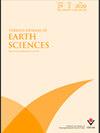Petrological characteristics of gabbroic intrusions in southeastern Urmia-Dokhtar magmatic belt, Kerman province, Iran: Evidence for post-Eocene mafic magmatism
IF 1.1
4区 地球科学
Q3 GEOSCIENCES, MULTIDISCIPLINARY
引用次数: 1
Abstract
: At the south of the Bardsir, Kerman province, Iran, the southeastern part of the Urmia-Dokhtar magmatic arc (UDMA), a large number of gabbroic intrusions are intruded into the Eocene lava flows and pyroclastic rocks with the form of small stocks and dykes. In this paper, geochemical variations, magmatic evolutions, and the origin of these intrusions are investigated. The studied intrusions are characterized by fine-grained margins resulting from rapid cooling and flow differentiation. They display porphyritic texture and include coarse-grained clinopyroxene with diopside compositions (Wo = 46.89, En = 40.78, Fs = 12.32), plagioclase with labradorite composition (An = 54.14), and olivine in an intergranular crystalline groundmass. Their whole-rock chemistry proves that the rocks belong to the calc-alkaline series. The abundances of trace elements and REE, depletion of Nb, Ta, Zr, Ti, and Hf, and enrichment of LILE relative to HFSE indicate that these rocks belong to a subduction zone setting. Geochemical characteristics (Sm/Yb and La/Sm ratios) show that the source rock of these intrusions was the lithospheric mantle with spinel lherzolite composition, which initially underwent partial melting (10% to 20%) events and then was metasomatized by fluids derived from the subducting Neo-Tethys lithosphere.伊朗克尔曼省Urmia-Dokhtar岩浆带东南部辉长岩侵入体的岩石学特征:后始新世镁铁质岩浆作用的证据
:在伊朗克尔曼省Bardsir的南部,Urmia-Dokhtar岩浆弧(UDMA)的东南部,大量辉长岩侵入体以小型岩堆和岩脉的形式侵入始新世熔岩流和火山碎屑岩中。本文对这些侵入体的地球化学变化、岩浆演化和成因进行了研究。所研究的侵入体的特征是快速冷却和流动分化产生的细粒边缘。它们显示出斑状结构,包括透辉石成分的粗粒斜辉石(Wo=46.89,En=40.78,Fs=12.32)、拉布拉多岩成分的斜长石(An=54.14)和粒间结晶基质中的橄榄石。他们的全岩化学证明这些岩石属于钙碱性系列。微量元素和REE的丰度、Nb、Ta、Zr、Ti和Hf的贫化以及LILE相对于HFSE的富集表明这些岩石属于俯冲带环境。地球化学特征(Sm/Yb和La/Sm比值)表明,这些侵入体的源岩是由尖晶石二辉橄榄岩组成的岩石圈地幔,最初经历了部分熔融(10%至20%)事件,然后被俯冲新特提斯岩石圈的流体交代。
本文章由计算机程序翻译,如有差异,请以英文原文为准。
求助全文
约1分钟内获得全文
求助全文
来源期刊

Turkish Journal of Earth Sciences
地学-地球科学综合
CiteScore
2.40
自引率
10.00%
发文量
6
审稿时长
6 months
期刊介绍:
The Turkish Journal of Earth Sciences is published electronically 6 times a year by the Scientific and Technological Research
Council of Turkey (TÜBİTAK). It is an international English-language journal for the publication of significant original recent
research in a wide spectrum of topics in the earth sciences, such as geology, structural geology, tectonics, sedimentology,
geochemistry, geochronology, paleontology, igneous and metamorphic petrology, mineralogy, biostratigraphy, geophysics,
geomorphology, paleoecology and oceanography, and mineral deposits. Contribution is open to researchers of all nationalities.
 求助内容:
求助内容: 应助结果提醒方式:
应助结果提醒方式:


